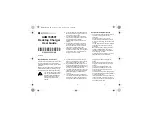
10
TROUBLESHOOTING - FAULT LED LIT
The following conditions may light the FAULT LED:
• Poor connection to battery (or frame).
• Charging too fast - Decrease Charge Rate - Press 2/10/20/40A button to lower rate.
• Charging too slowly - Battery is large and did not complete charging in 24 hours - Press 2/10/20/40A to charge at a faster rate.
• Shorted battery cell - Replace battery (F01).
• Open battery Cell - Replace battery (F03).
• Battery sulfated - have battery serviced or replace battery (F03).
• Reverse Polarity LED Lit - disconnect AC then reverse clamp locations on battery and frame.
• Internal over-heat in charger- make sure fan is not blocked (F05).
Try charging another battery, if the FAULT LED does not light, then one of the above problems exists with the initial battery.
Charger will not charge and the fan will not operate if there is a fault. Call Vector Technical Support toll
free: (866) 584-5504.
SULFATED BATTERY (F03)
Batteries left in a discharged state for a long period of time are likely to become "sulfated". Sulfated batteries cannot
accept a high rate of charge since the internal plates are coated with lead sulfate. To determine if a sulfated battery can
be "saved", follow the instructions in Battery Recondition.
INTERNAL SHORT CELL BATTERY (F01)
• If the battery being charged has an internal shorted cell, the FAULT LED will light.
• If FAULT LED light comes on, Vector recommends you take your battery to a certified automotive service center
for evaluation.
BATTERY NOT ACCEPTING A CHARGE
• Make sure that the charger is plugged into a "live" 110/120VAC outlet and Power LED is lit.
• Unplug charger and check battery connections - ensure that there is a good connection at the battery terminal and/or
vehicle chassis.
• Check the battery for sulfated condition.
• Check that the correct charge rate was selected for the battery being charged.
• Ensure that enough charging time was allowed for-check table in Appendix A (page 11)for approximate
charging times.
VERY COLD BATTERY
If the battery to be charged is extremely cold (in temperatures less than freezing - 0º C/32º F) it cannot accept a high
rate of charge, so the initial charge rate will be slow. The rate of charge will increase as the battery warms.
CHARGER FAILS TO CHARGE AND DISPLAYS AN F02 CODE:
This can mean several things, including no connection to a battery, but it can also occur if the battery is both
discharged and under a loading situation. This can happen if an accessory (dome light, radio, etc.) is on and remains on while
attempting to charge. It can also happen if a diode in the alternator is leaky and has totally discharged the battery the battery to a
voltage of less than 4 volts. The best remedy for this situation is to remove one of the two cables from the battery and allow the battery to
self recover to a voltage of above 4 volts DC. The battery may take several hours or more to recover to this voltage which then allows the
charger to operate. Once the battery has recovered enough to allow charging, it is best to charge at the lowest possible charge rate. Even
at that, it may take a few charging cycles to make the battery fully recover from such a deeply discharges state.
VEC1093 A
REV101103
NOTE:
Non-deep cycle batteries that have been deeply discharged may NEVER fully recover to their original ampere hour capacity
and should be considered as suspect, especially in critical application. Additionally, if a battery does not self-recover to a voltage of
4 volts or more, it is doubtful that it can ever be fully re-charged and considered reliable. Further, batteries that have been fully
discharged and allowed to remain so for extended periods of time, should be considered suspect and reconditioned or replaced.
NOTE:
Charger will NOT operate on batteries below 4.0 Volts. If a 12 Volt battery is below 4.0 volts it is probably
shorted, open or sulfated and should be replaced.
WARNING:
DO NOT attempt to charge a frozen battery.






























